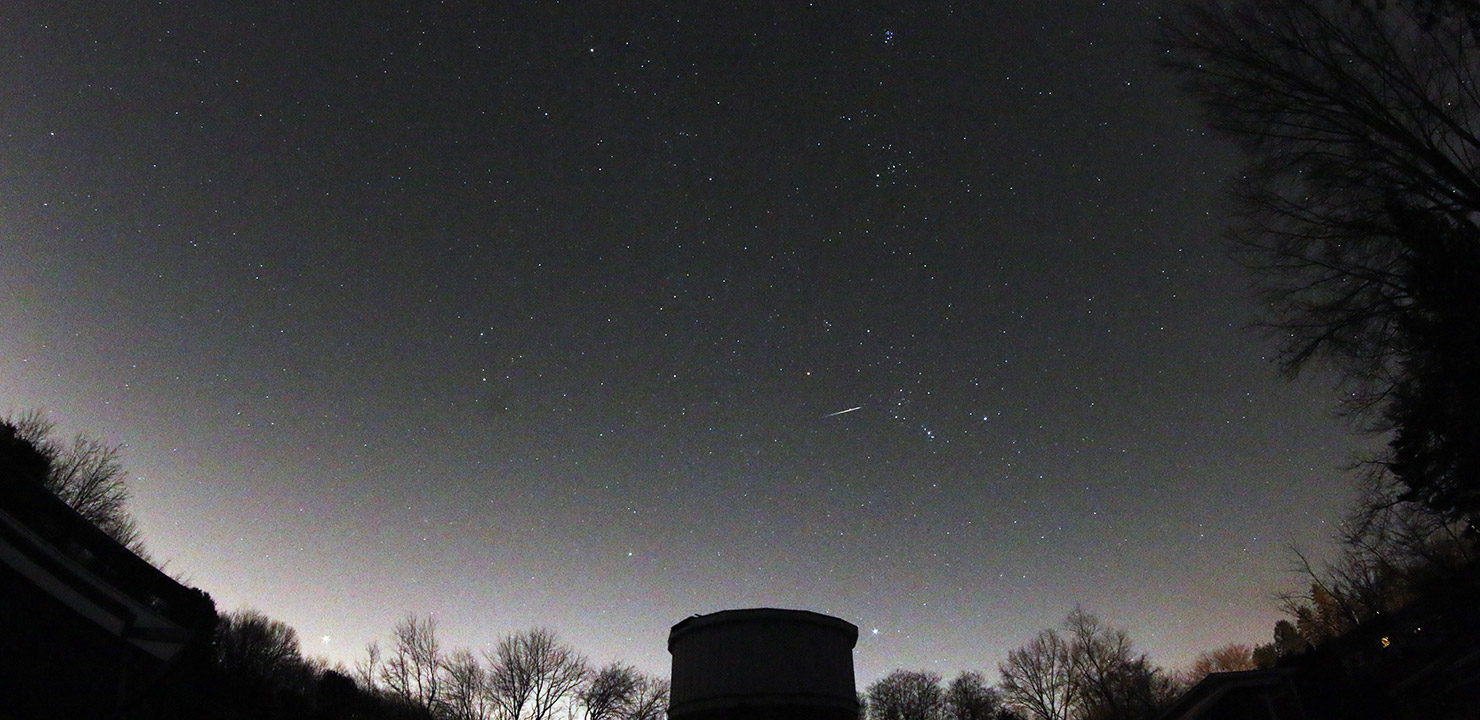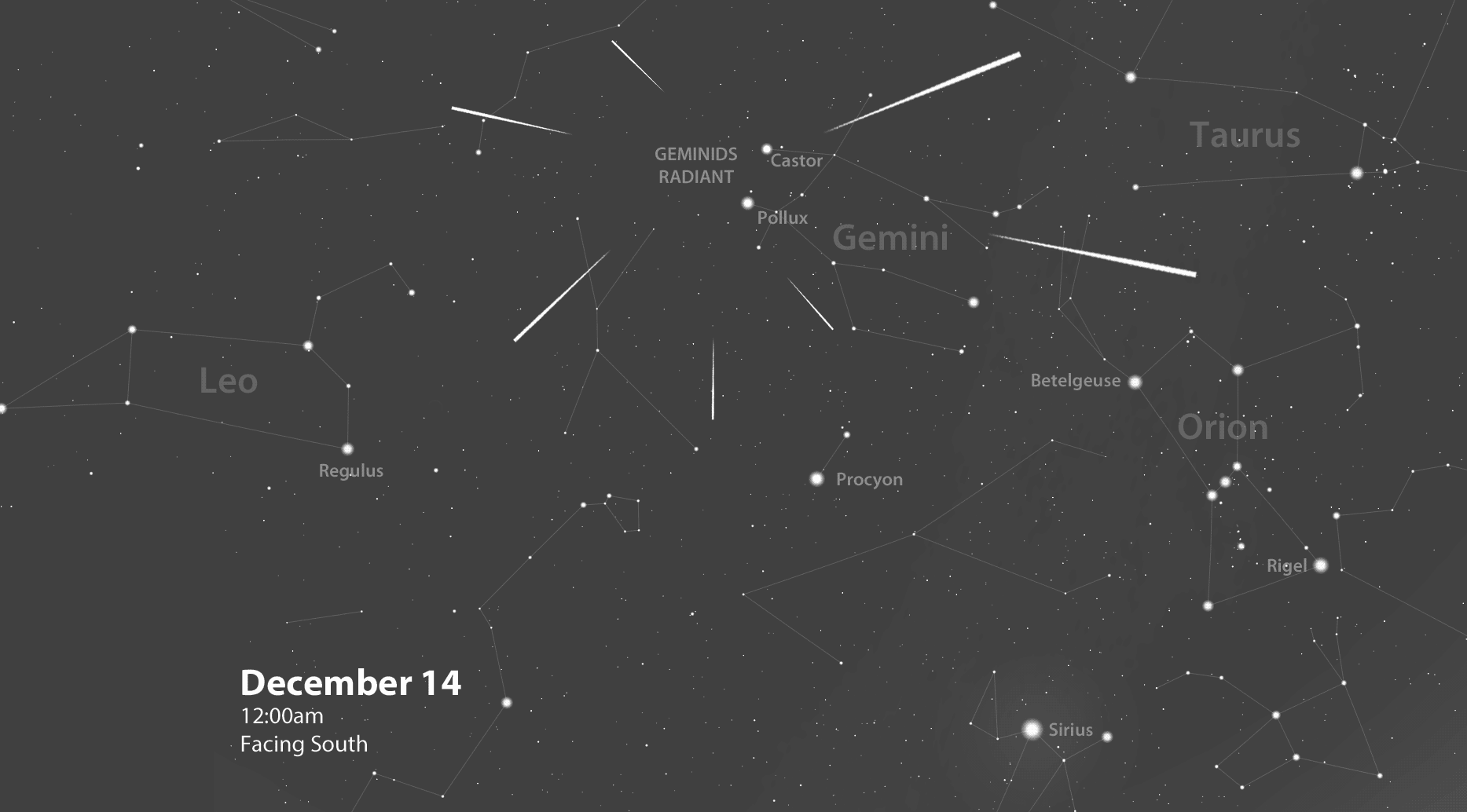
A "Gem" of a Meteor Shower and Other Stargazing Highlights
December 2017 :
Note: This article may contain outdated information
This article was published in the December 2017 issue of The Skyscraper and likely contains some information that was pertinent only for that month. It is being provided here for historical reference only.
Another year of enjoying the heavens is rapidly drawing to a close. We’ve been fairly successful in viewing many sky events in 2017, the best being the August 21 solar eclipse. We can only hope good weather prospects will continue for just a little while longer so we can wrap up the year with some decent astronomical viewing.
First up on December 3 will be a so-called supermoon. This Full Moon will be the closest full moon of the year at a distance of 222,443 miles. The average distance is 238,500 miles. But don’t let that fool you. The vast majority of folks will not be able to distinguish visually December’s supermoon size from any other Full Moon. It will, however, get everyone talking about the Moon and that’s good free public relations for local astronomical societies.
During the first week of the month you will definitely notice a brilliant “star” above the eastern horizon before sunrise. However, it is not a star. It’s the planet Jupiter. This giant world joins Mars for early morning viewing. The two planets will be moving closer to each other in the sky as the days proceed, coming closest to one another (conjunction) on the mornings of January 6 and 7. If you want to get up early to observe these planets with a telescope, Jupiter’s large disk will show a wealth of detail, while much smaller Mars will reveal little surface detail.
Near-perfect astronomical conditions will prevail for this year’s best meteor shower, the Geminids, which will peak on the night of December 13-14. The Moon will be a thin waning crescent rising in the east around 3:23 a.m. Gemini will be on the opposite side of the sky, so the Moon’s faint illumination will not interfere with observing as many meteors as possible.
As with observing any meteor shower to best advantage, one should choose an observing location as far from interfering light pollution as possible. Also, do not remain standing too long to observe this display. Sit or recline in a comfortable lounge chair. Dress in layers. Climb into a sleeping bag if possible. Wear a hat to keep heat from escaping through your head. Wear warm mittens, not gloves. Mittens keep your fingers together for added warmth. You can also use a few of those pocket warmers to keep extremities toasty.
One important fact to remember is that the Geminids are one shower that can be observed before midnight. You won’t see the peak rate, but if you can’t scan the skies after midnight at least you will be able to observe more than a handful before the midnight hour. And there may be some earthgrazers within a few hours after sunset. With Castor and Pollux rising around 5:30 p.m. and 6:00 p.m. respectively, our observing vantage point will show an occasional Geminid skimming tangentially across the top of Earth’s atmosphere and parallel to the horizon. This scenario provides for much longer streaks, often looking like a stone skipping across a pond.

While the Geminids appear to emanate from Gemini near its brightest stars, Castor and Pollux, scan around the sky as much as possible. As the night progresses and Gemini moves across the sky towards the west, your scan should move as well. At around 2:30 a.m. Gemini will be on your meridian, just south of zenith. With clear and dark skies a keen-eyed observer should see 60+ meteors per hour during the peak activity between midnight and dawn. If you care to conduct an accurate count, you should notice the number of meteors per hour increase as the night progresses, and then begin to decrease as dawn approaches.
The Geminids are fairly bright and moderate in speed, hitting our atmosphere at 21.75 miles per second. They are characterized by their multicolored display (65% being white, 26% yellow, and the remaining 9% blue, red and green). Geminids also have a reputation for producing exploding meteors called fireballs.
Next up on our astronomical calendar is the Winter Solstice, which occurs at 5:44 a.m. EST (Eastern Standard Time) on the 21st. This event marks the beginning of winter in the northern hemisphere. Notice how low an arc the Sun travels across the sky. After this date and time the Sun’s arc will rise higher and higher each day as it appears to travel northward in our sky, reaching the Vernal Equinox (spring) on March 20, 2018 at 12:15 p.m. EDT (Eastern Daylight Time). The apparent shift of the Sun’s position in the sky is the result of the Earth’s fixed axial tilt of 23.5 degrees as it revolves around the Sun.
And finally to round out the year, local astronomers will be able to observe yet another occultation of constellation Taurus’ brightest star Aldebaran. During the early evening hours of December 30 the dark limb (left side) of a waxing gibbous Moon will occult (pass in front of) Aldebaran at approximately 6:28 p.m. EST. As the Moon continues to slide eastward in the sky Aldebaran will remain hidden for about 51 minutes. At approximately 7:19 p.m. Aldebaran will emerge along the Moon’s bright limb (right side). Occultations by the Moon are always fascinating to watch, as one can often see the occulted object blinking in and out from behind lunar mountains or crater rims. Binoculars or a small telescope will facilitate your observation of this event.
Lastly, as we approach the holiday season, many folks ask me about the mystery of the Christmas Star. An unabridged version of my latest treatise on this topic can be found on the Skyscrapers’ website http://www.theskyscrapers.org/mystery-of-the-christmas-star for your examination.
Seagrave Memorial Observatory in North Scituate is open to the public every clear Saturday night. However, in December Seagrave will only be open on the 2nd and 16th. Ladd Observatory in Providence is open every clear Tuesday night. The Margaret M. Jacoby Observatory at the CCRI Knight Campus in Warwick is open every clear Thursday night. Frosty Drew Observatory in Charlestown is open every clear Friday night year-round.
Happy holidays and clear skies to all.



